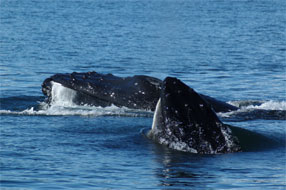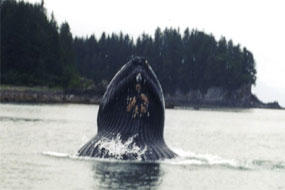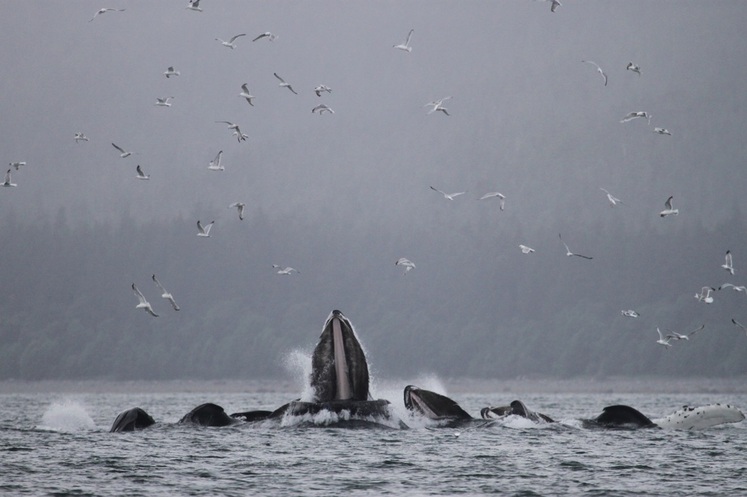Feeding
Because food is unavailable to humpbacks in the breeding areas, they sustain a focused feeding effort throughout their stay in northern latitudes, where food is abundant. With the exception of traveling and short rest periods, humpbacks in Alaska are feeding virtually all day and night. When the prey source is subsurface, whales will spend only short periods at the surface to breath in between longer (5-8 min) foraging dives. At other times, humpbacks can be seen feeding on surface prey by skimming the surface of the water, or lunging, mouths open to the surface.
Filter Feeding
Humpback whales are filter feeders, they obtain food by engulfing large amounts of water and prey (small schooling fish, or small crustaceans such as euphausiids and copepods often called krill) and push the water back out of their mouths through baleen plates which act to sieve and retain the prey in the whale’s mouth. Their mouths have some interesting features which make this feeding strategy possible.
- They have an expandable throat space. The ventral pleats can expand to accommodate thousands of gallons of water and prey in a single mouthful.
- Humpbacks have a tongue that is both huge and powerful. It is the tongue that really forces the water out of the throat cavity and through the baleen. Once strained, it is the tongue that licks the fish and krill from the baleen plates so they can be swallowed.
- Their actual throat it relatively small, at largest, this is only about as large around as a basketball. Baleen whales have a digestive system capable of processing only small organisms; the restriction at the throat assures that only small and digestible organisms are swallowed.
- Most importantly, humpback whales have several hundred baleen plates which allow them to separate the food and seawater. They are oriented on the upper jaw in the place of teeth with the fringe positioned towards the inside the mouth. Because the pieces are arranged so closely in the mouth, the roof of a humpbacks mouth looks more like a mat of hair than individual plates of baleen.
Bubble Net Feeding
Occasionally, humpbacks in Southeast Alaska will feed in coordinated groups using bubbles to trap fish at the water’s surface. This behavio r is known as bubble net feeding. Bubble net feeding involves anywhere from 4-20 whales all working together to herd schooling fish into dense schools in order to maximize the feeding productivity of the group.
While many other whales and other animals use bubbles to assist in prey capture, the specific methods used in this complex feeding strategy are unique to whales in Southeast Alaska and are seen only in certain areas and seasons. To summarize the bubble net technique; a group of humpbacks will dive down to herring schools where one whale (the bubble-blower) will release a ring of bubbles from its blowhole as it spiral beneath the prey. As this air rises to the surface, it creates a curtain of bubbles that acts as a physical barrier to frighten and retain the school of herring. Simultaneously, another whale in the group will produce resonating vocalizations, which also act to frighten the prey and trigger them to school up in tight balls within the bubble net. The whales then orient below the schooled fish and lunge, mouths open, to the surface through the center of the bubble ring, or bubble net. This motion drives the fish to the surface, where they are trapped from all sides (the surface of the water above, the bubble curtain on the sides and the open mouths of whales below). The whales will break the surface of the water in unison with mouths wide open, and then close their mouths while roll at the surface as they force the water from their throat cavity out through their baleen plates; the sieving process which allows them to swallow their catch without having to swallow excess saltwater.
While many other whales and other animals use bubbles to assist in prey capture, the specific methods used in this complex feeding strategy are unique to whales in Southeast Alaska and are seen only in certain areas and seasons. To summarize the bubble net technique; a group of humpbacks will dive down to herring schools where one whale (the bubble-blower) will release a ring of bubbles from its blowhole as it spiral beneath the prey. As this air rises to the surface, it creates a curtain of bubbles that acts as a physical barrier to frighten and retain the school of herring. Simultaneously, another whale in the group will produce resonating vocalizations, which also act to frighten the prey and trigger them to school up in tight balls within the bubble net. The whales then orient below the schooled fish and lunge, mouths open, to the surface through the center of the bubble ring, or bubble net. This motion drives the fish to the surface, where they are trapped from all sides (the surface of the water above, the bubble curtain on the sides and the open mouths of whales below). The whales will break the surface of the water in unison with mouths wide open, and then close their mouths while roll at the surface as they force the water from their throat cavity out through their baleen plates; the sieving process which allows them to swallow their catch without having to swallow excess saltwater.
Perhaps the most amazing aspects of this feeding behavior are in the precision and organization of the group. The whales in a bubble netting group will surface in the same relative orientation with each successful bubble net, in some ways this behavior can be viewed as a highly organized dance. Further, it is fascinating that these animals are capable of coordinating this behavior while partitioning tasks to increase the overall efficiency. This behavior signifies complex social interactions within humpback whale populations, which are poorly understood and documented.




